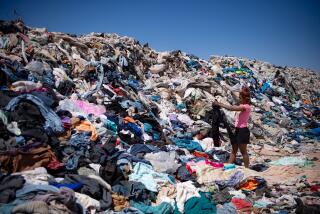North America’s Mountains of Refuse : Problem Mounts: Where to Put Trash?
- Share via
OTTAWA — Each week, thousands of Canadians trot out to the curb on garbage day carrying an extra bundle--a plastic blue box jammed with empty glass jars, tin cans and newspapers.
Picked up by special trucks and delivered to recycling centers, the waste is reincarnated into various new products in a program that is at the forefront of similar efforts across North America.
Environmental experts say that while such steps are positive, they are only small ones for the continent, which leads the industrial world in producing waste but lags in efforts to reuse it.
Just the First Step
“It’s the first step, but there are many, many more to be taken,” said Jill Dunkley, information manager at the Recycling Council of Ontario, where more than 1 million households participate in recycling programs.
The experts are unanimous that there is a garbage crisis at hand. Many North American cities are in danger of being crowded out by their own refuse as they search for more and more places to dump it.
In New York, workers are building a towering mound of trash on Staten Island that the locals have dubbed Mount Trashmore. Officials in New York and other cities say that within a few years, all existing dump sites will be filled.
Canada, with a population of 26 million, produced 16 millions tons of garbage in 1986, or 4 pounds per person each day.
The United States fared only slightly better, producing 145 million tons of garbage, or 3 1/2 pounds a person. West Germany, Sweden, and Japan all produce much less garbage per capita, about 2 pounds per person.
Only 2% of Canadian garbage and 15% of American trash is recycled. The rest is hauled to landfills or incinerated.
In contrast, West Germans recycle 15% of their waste, while the Japanese find new uses for an astonishing 50% of their trash.
But there are glimmers of hope. Recycling is more than just the latest fad. Businesses, municipalities and individuals are showing new resolve to tackle the problem.
“I believe many people want to do it,” said Doris Cellarius, a recycling expert for the Sierra Club. “But we really haven’t got the nation together in a big way.”
Several cities on the continent have passed new recycling laws.
The Minneapolis city council recently passed a tough plastic food packaging ordinance, banning any plastic packaging that cannot be recycled, including egg containers and foam meat trays.
With much fanfare, seven leading polystyrene companies, including Dow Chemical Co., Mobil Corp. and Atlantic Richfield Co., formed the National Polystyrene Recycling Co. to recycle used foam cups and containers.
Five plants are to be constructed to grind the old material into small pellets that will be resold to manufacturers such as packaging companies and toy makers.
While foam food containers may not be the biggest problem at overflowing landfills, company officials are hoping the project will set an example.
Prototype Project
“This is probably a prototype of what should be done with other products,” said Kenneth Harman, business director of polystyrene products for Dow Chemical.
Environmentalists say the next big step is getting at kitchen waste--the egg shells, fruit peelings, meat scraps and coffee grounds that make up about 10% of landfill.
Toronto, Canada’s largest city with a population of about 3 million, recently launched a “brown bin” pilot project in which citizens can buy compost bins for $10. The waste is collected in the bins and broken down into a crumbly substance that can be reused as garden fertilizer.
More to Read
Sign up for Essential California
The most important California stories and recommendations in your inbox every morning.
You may occasionally receive promotional content from the Los Angeles Times.













